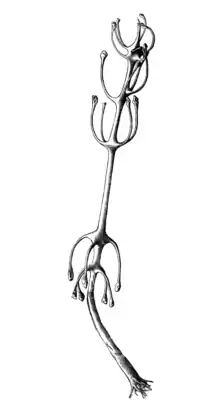Chondrocladia concrescens
Chondrocladia concrescens (formerly Cladorhiza concrescens), is a carnivorous sponge in the family Cladorhizidae. It is thought that the object known as the Eltanin Antenna may be an individual of this species.[2] Alexander Agassiz described the sponges as having "a long stem ending in ramifying roots, sunk deeply into the mud. The stem has nodes with four to six club-like appendages. They evidently cover like bushes extensive tracts of the bottom."[3]
| Chondrocladia concrescens | |
|---|---|
 | |
| 1888 illustration by Agassiz | |
| Scientific classification | |
| Kingdom: | Animalia |
| Phylum: | Porifera |
| Class: | Demospongiae |
| Order: | Poecilosclerida |
| Family: | Cladorhizidae |
| Genus: | Chondrocladia |
| Subgenus: | Chondrocladia |
| Species: | C. concrescens |
| Binomial name | |
| Chondrocladia concrescens (Schmidt, 1880)[1] | |
| Synonyms | |
| |
References
- Vacelet, J., van Soest, R. (2014). Van Soest RW, Boury-Esnault N, Hooper JN, Rützler K, de Voogd NJ, de Glasby BA, Hajdu E, Pisera AB, Manconi R, Schoenberg C, Janussen D, Tabachnick KR, Klautau M, Picton B, Kelly M, Vacelet J (eds.). "Chondrocladia (Chondrocladia) concrescens (Schmidt, 1880)". World Porifera database. World Register of Marine Species. Retrieved 2014-04-30.
- Heezen, Bruce C.; Hollister, Charles D. (1971). The Face of the Deep. Oxford University Press. p. 35. ISBN 0-19-501277-1.
- Agassiz, Alexander (1888). Three cruises of the United States Coast and Geodetic Survey Steamer "Blake". Houghton Mifflin. p. 177.
This article is issued from Wikipedia. The text is licensed under Creative Commons - Attribution - Sharealike. Additional terms may apply for the media files.